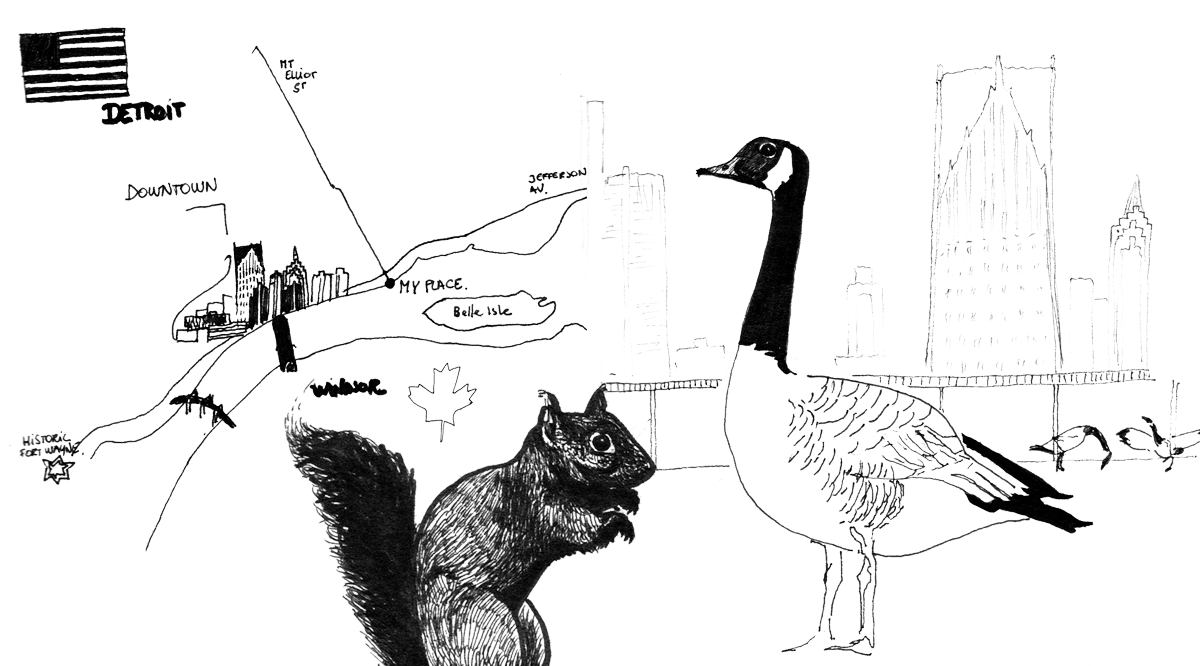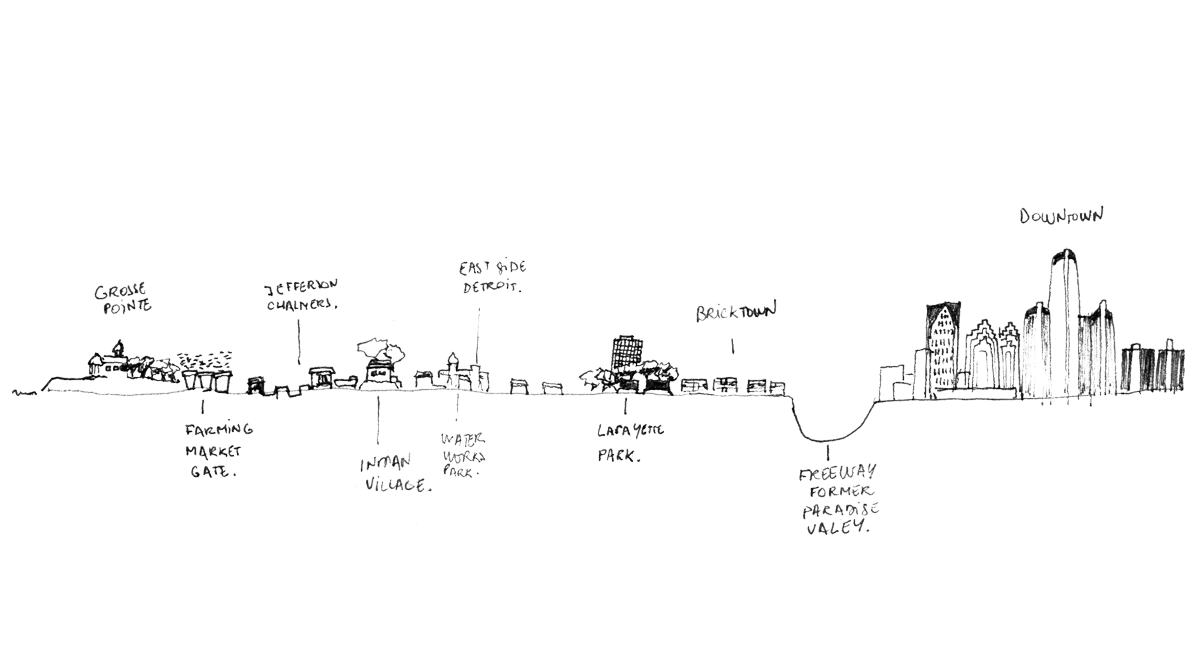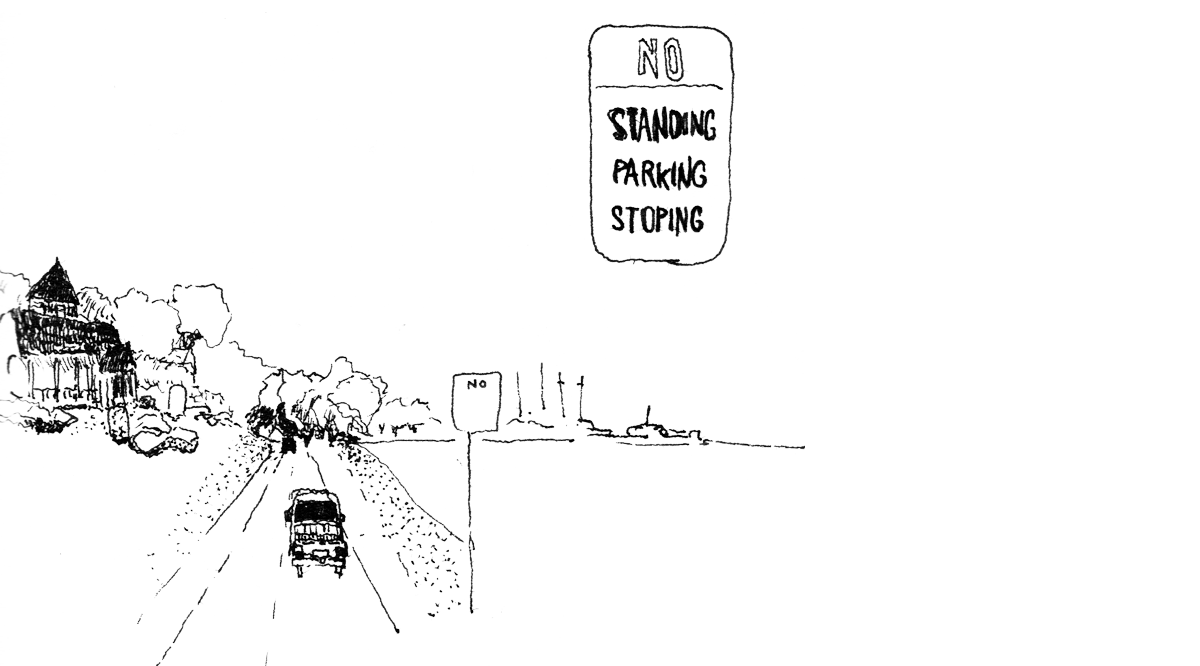
Awaken by a recorded cavalry trumpet, as I went to my RBNB home for the week window, I saw star spangled banner raised up on the top of what appeared to be US detention & Deportation facilities. Feeling comfortable with this, as a temporary immigrant, I went on an early walk to find a grocery store in the neighborhood. Taking not any care of the « no trespassing » formal order black squirrels were passing in front of me through US administration’s fences. I counted something like 12 of them before I arrived at the destination, 2 blocks away. Seeping my very first true American soda, I crossed Jefferson avenue to continue walking along Mont Elliot street.
Herds of black & white Canadian geese were grazing greeneries of the high school football field and then later, in mont Elliot cemetery. As I was looking at them from the other side of the street, I turned right at the Capuchin church. One bloc eastern, vacant lots appear quite suddenly. It gives this strange impression of passing through the mirror in a dystopian version of Alice in Wonderland. Once I was in a quite regular suburbian atmosphere, then brutally in the wasteland. As if I had been diving in water from the tip of an island.

Jefferson Avenue has been a natural pathway to my Detroit experience. As I used it by bike, foot & car on many different trips. It will play the role of a reference plane in a cut view in this story. I drew this cut from memory.
There might be some imprecision, each places are not directly connected to Jefferson, but they are on the pathway.

Riding along the riverfront in Detroit is crossing its first establishment as a French colony. I don’t know if my immediate familiarity with these spaces come from this master plan, but it could feel like. French colonies, as Detroit, used to be settled along rivers following what they call ribbon farms. Ribbon farms are long, narrow land divisions, usually lined up along a waterway. Near Detroit, the ribbon farms were about 250 feet wide and up to three miles long. The ribbon farm layout gave multiple landowners access to the river.
I have seen this pattern on Gaston Roupnel works about French countryside history. The community used to share the land this way in Beauce region as they established.
After the first fire reducing french Detroit to ashes, Judge Woodward designed a radial plan for downtown. He made it following the orientation of the former one, and structured space by a network of streets parallels with the riverfront. This radiality was an attempt to help Detroit growing in the future. I met Woodward name many times, as one of the main road of Detroit – part of his master plan – is named after him.
A third canvas has been used to design Detroit.The
These three successive patterns show different focus; a context & resource-driven design, a development & growth driven design and an orientation & circulation driven design. It’s interesting to see how urban forms get autonomy from their context.

Highly contrasted city
I went to Grosse Pointe with my friend Carl Niellbock on the first day of my trip. He is a master craftsman in ironworks. We visited a construction site he has in the location. At the back of the pickup driving me to the place with the other guys on board, I lowed my head to pick a piece of paper in my bag. As I was giving an eye back to the road, I couldn’t help to say something like: « Gosh ! it seems that every kid on the street turned white. » We just had arrived in Grosse Pointe. One of the richest cities in the US is linked to Detroit so tightly, that you can’t figure on a map that there is a rupture between bothof them. It’s still Detroit Urban fabric but the ambient atmosphere is changed from the very beginning.
There is no fences or really visible gates like you can see in other gated community in Detroit. Grosse Pointe People deploys more subtle strategies to make sure to enjoy this space with their pairs.
Nice & huge mansions, enough green spaces between them to locate a golf course, perfectly sculpted topiaries, aged tries, … Each sign of richness for sure. It comes with space control strategies. Between other examples, Gates are guarded in a way or another from the obvious city hall at Jefferson entry point to the « fake » farm market at Kercheval & Wayburn crossing.
On the riverfront road, Jefferson becomes lakeshore drive, the time it takes to cross Grosse pointe farms. Big mansions are lying upon green banks behind the street. Their dominative position and the space between road & buildings is the only fence. The shore is planted with uniform green grass. Alternately stand a roadsign – no standing, parking, stopping-no fishing, staying, picnicking- Public authority is there to make sure that tenants can have full & exclusive use of the Lakeview. As one could say, « No need for
Maker City
I felt so jealous by visiting POST collective workshop ( Jefferson Chalmers), Talking dolls or OMNICORP hackerspace! How well equipped & well organized are these guys! And, surprise how economically healthy they seem to be! I have been working myself as a designer-maker and studied that phenomenon 10 years ago as I was designer-researcher. I know a bunch of designer working this way in France in many different places, and a lot of talented craftsmen. The least I can say is that it’s hard to make a sustainable business this way.
A Culture of making.
Carl Nielbock has been trained for decades as a craftsman in Germany before going to Detroit. He notices that there is no real Craftmanship or « métier
Fighting for autonomy.
Another particularity of this making culture is an important preoccupation for autonomy & self-sustainability.
> Design-Production you do it yourself, make it yourself – at least prototype yourself, and sell it yourself to diffusion.
> Land owning -As Carl Nielbock enthusiastically remark, you do what you want with your property: it’s the best with the USA !
-owning their facilities is the best option to secure investment on an insecure and changing land. As an example of this instability, Ron Watters (Talking Dolls) explains to us that Municipality taxes rainwater roof, following water amount of the month. If finding money to pay for the water collect seems a necessity, this taxes unpredictability is a threat to their development.
> Energy self-production CAN art shows an extreme form of self-empowerment since facilities are full powered by own-designed wind-mills.
Community involvement.
These working communities grew by opening their workshops to others. These informal exchanges policies, based on trust produces strong communities, really involved in what they do. One could regret that they recruit their pairs in gender & race. To be honest, it depends on leadership & meeting occasions of the whole making community. This community commitment as part of vitalizing neighborhood gives really positive side effects. This attitude as Ron Testimonial seems to say gives his company local support & a positive environment
The Equation of successful design+making community seems to be linked with 3 essential components:
– available & affordable space (tick, we have it too in Saint-Etienne !)
– A base market, Detroit remains an important city with rich suburbs.
– Branding Detroit, which settles on this commitment to community & maker values
Using the riverfront bike path has been really interesting because it shows how easy to use & attractive this city can be with proper urban design. Contrary to what I expected, this
There is an interesting paradox here in detroit with water. As it is present every where, Detroit is a side lake city, it seems to be something rare & difficultly affordable in the city.